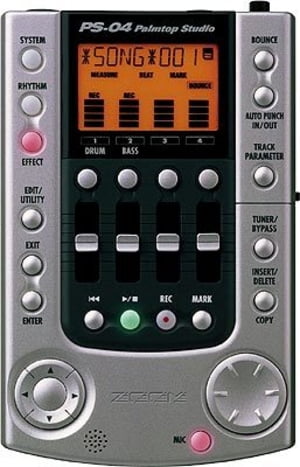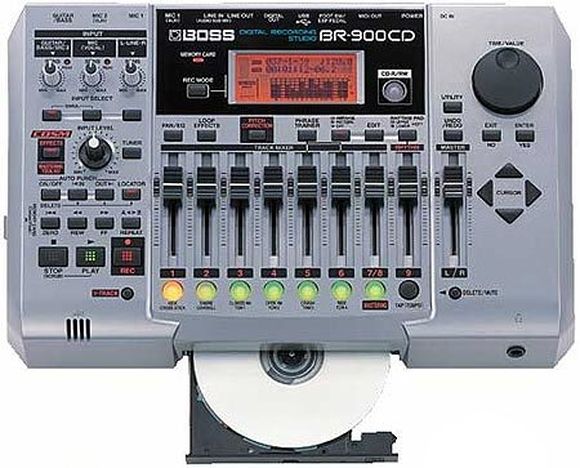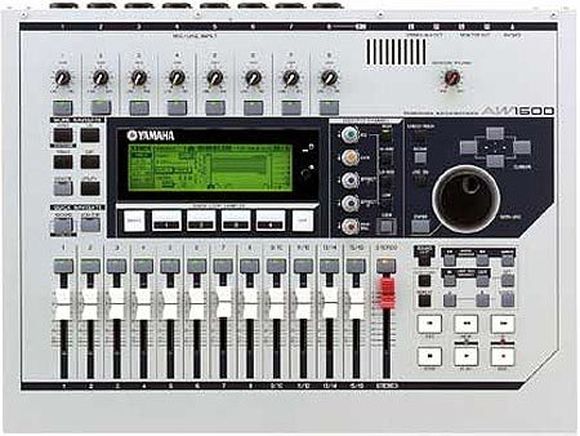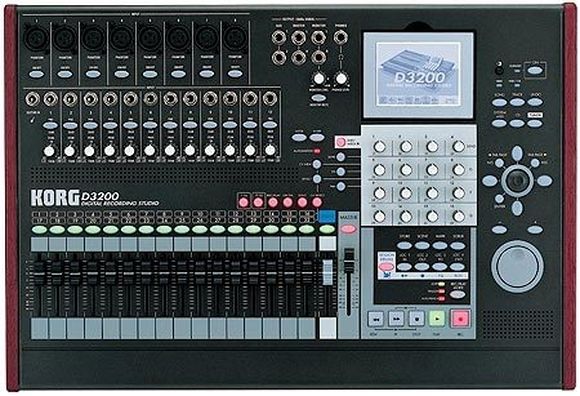2. Catergories
It’s all so easy! The steady and progressive development of electronics in recent years has not only brought us more powerful digital recording devices, but also made them smaller. Because of this it is now possible to make high quality recordings in almost any location and since most of the offered devices are self-sufficient, you don’t need additional equipment like effects devices, amps, or drum computers.
Although categorization can be a tricky thing, we would like to try and sort the extensive offerings before beginning our little trip into the world of multitrack compact studios. Here is what we’ve come up with:
Ulra-compact Pocket Multitracks (4-Track)
…a practical “always there solution”. Normally these come with optional battery operation, an integrated drum computer, amp/effect modeling and the ability to fit in any gigbag, making them ideal for recording song ideas in hotels, practice rooms, tour buses etc.

Compact Beginner Multitracks
Also very compact devices (Measurement for ex. 452 mm x 110mm x 307 mm, weight: 4-5kg) they offer 8 tracks and save the recorded data (depending on the model) on hard drives or flash memory. They have an increased array of integrated effects as well as amp modeling, often programmable drum computers, a CD burner, and are able to make very good recordings. Making them ideal for pre-production, demos and sophisticated home recordings. An important thing to note is that they usually only allow for two tracks to be recorded simultaneously.

Semi-professional Multitracks
Normally with 16 tracks and the possibility to record 8 instruments simultaneously (a drum set for example), these multitracks like Yamaha’s AW1600, the BOSS BR-1600, or the ZOOM MRS-1608 are ideal for the artist thinking about end production. The recording and equipment quality are so good that professional songs can be produced without issue. Perfect for traveling musicians or those with a space issues, these multi-tracks offer a lot of studio in a small space with their low weight and easy set up.

Semi-Professional/Professional Multitrackers
With 24 to 32 tracks, lavishly equipped input sections (XLR inputs with phantom power) mixers, and the ability to record up to 16 tracks simultaneously, professional multitrackers are ready for any job in the recording business. Whether demanding home recordings, perfect demo recordings, or professional studio work, these devices are ultimate all-in-one solutions, including excellent editing and mastering tools with high-quality integrated effects units.

- Digital Editing
- Location Points
- Track Bouncing
- Punch In/Out
- Auto-Punch
- Mute and Solo
- Sample Rate
- Mastering
- Non-Linear Editing
- What is 'Digital Recording'?
- What is encoding?
- What is a 'marker'?
- What are patches?
- What is 'speaker simulation'?
- What is the undo function?
- What are virtual tracks?
- What is 'amp-modeling'?
Just as you are able to manipulate text in a word processor, you can also cut, copy, paste and insert audio tracks on multitrack recorders.
These enable you to visually mark specific points of a song such as verses and choruses, so that you can quickly and conveniently navigate around without having to continually search through– highly convenient when used in conjunction with copy and paste functions.
If you’re running out of tracks, you can mix several of them down to one or two in order to free them up. This is a handy trick, but care should be taken, as unless you’re using virtual tracks, you cannot later remix.
This feature is often used to replace mistakes or re-record parts of a track that could have been performed better. It lets you enable and disable recording while playing back the song to record the part on the fly. Also sometimes referred to as ‘dropping’ in/out.
Short for ‘Automatic Punch In/Out’, it makes punching in and out both easier and more precise. Typically available on higher-end multitrackers, the feature allows users to set ‘in’ and ‘out’ recording points, which will cause the recorder to automatically drop in and out of record.
Pressing a track’s mute button will simply remove its output from the mix until the button is pushed again. Soloing a track produces the opposite result - all channels are muted except the one being soloed.
The sample rate is a measure of how many times per second the source material is being ‘sampled’. Sample rate affects the frequency response of the final recording - the highest frequency that can be accurately represented is just under half the sample rate. Generally speaking, the higher the sample rate, the better the sound quality, but the most sensible sample rate to use will depend on your system - the higher the rate, the more storage required, and sometimes the lower the track count. The law of diminishing returns definitely applies here – 96kHz does not sound twice as good as 48kHz!
The process whereby recorded material is taken from the multitracker and prepared for duplication in the format of the final release. This can include any or all of the following - equalisation, compression, limiting, normalisation, stereo widening, fades, and simply arranging the songs in the desired order.
The editing of audio on a system that has the ability to randomly access data, with the upshot that the user can define a region and move it forward or backward in relation to other regions.
Audio information saved as digital information. Can be stored on the following mediums: Magnetic band (video cassettes), hard drive, or removable storage such as discs and SD cards.
Refers to reducing the amount of data from audio and video recordings by using a variety of data compression methods. Among the best known variants is the MPEG 3 (MP3) format.
An electronic marking of a specific part of a song, allowing you to narrow down certain areas of an audio track to be replaced or copied. Also serves to mark the entry and exit points in the punch in / out process.
Completed effect presets.
Digital adjustment of the sound characteristics of guitar or bass amps.
Many digital recorders work with a protective recording system. When dubbing tracks, the "deleted" data is stored until it is finally sent to data nirvana when the song data is optimized. The original tracks are recoverable until then by using the 'undo' function.
Each of the main tracks on a digital recorder is divided into up to 10 sub-tracks, depending on the device. The 'v-trax' offer the possibility of recording different takes (versions) of the same song part. You only need to choose one of the virtual tracks when it comes time to mix the recording.
Digital reproduction of the sound characteristics of guitar or bass amps.
Yhteyshenkilösi
Product Highlights
Tarjoukset
-
Digitaaliraiturit






